|
present Book Reviews For Amateur & Avocational Archaeologists |
 |
|
present Book Reviews For Amateur & Avocational Archaeologists |
 |
Mississippian
Archaeology
Southwest United
States
Southeast United States
Mississippian Complexes
All Other United States
Mesoamerica and South America
International (Europe, Africa,
Asia, Caribbean)
Back to Main Book Review Index
|
| Home | Gallery | Latest Finds | Back to Main Book Review Index |
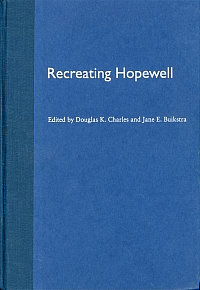
|
Recreating
Hopewell edited by Douglas K. Charles & Jane E. Buikstra University Press of Florida 2006 First ed. ISBN# 0-8130-2898-1 cloth hardcover This important volume is composed of papers presented at a major conference hosted by the Center for American Archaeology concerning "Perspectives on Middle Woodland In The Millennium" held in June, 2000. The conference generated many interesting papers, but at the time, there was not enough funding to publish the presentations and hold the conference. Since the presentations were groundbreaking and "out of the Middle Woodland box," the editors pressed forward with plans to later publish most, but not all, of them in one volume. This book is the result of that effort: The first such publication about Hopewell in over 25 years. The volume is broken up into four sections that include: Hopewell in Ohio, Hopewell/Middle Woodland outside Ohio, New Approaches to Hopewell Material Culture, and Recreating Hopewell Commentaries. Within each section are publications that illuminate the topic and overall cover the work of scholars and archaeologists across Ohio, Michigan, Wisconsin, Illinois, Missouri, Tennessee, and Georgia. What's interesting is that what evolves is a Hopewell culture with considerable differences in culture across the states represented. We see Hopewell as a diverse culture. Every imaginable facet of Hopewell life is examined in some detail. Settlement patterns and the use and layout of Hopewell communities are discussed at length. How communities sustained themselves, and the efficiency of Hopewell communities are also iterated with a profusion of charts, graphs and drawings. Death rituals, lithic production, community interaction: There simply is nothing left out here, and the serious scholar of Hopewell life will find a veritable treasure chest of references to use in their work. This book will be referenced for some time to come as it considerably broadens the context of Hopewell life from what was previously understood. If you are interested in this great,
ancient
American civilisation, this book is a must-buy for your library! Recreating
Hopewell sells for $75.00 and can be
ordered
direct from the publisher by clicking here. reviewed
by
Bob
Wishoff
|
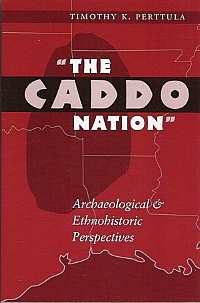
|
The Caddo
Nation: Archaeological &Ethnohistoric Perspectives by Timothy K. Perttula University of Texas Press 1997/2006 re-release ISBN# 0-292-76574-6 paperback This re-release in paperback of the The Caddo Nation is an important contribution to understanding this Indian society at the cusp of the historic period and its transformation. It presents “…through archaeological, historical, ethnographic and archival means the nature of contact and interaction between the Caddoan Indian peoples of Texas, Louisiana, Oklahoma, and Arkansas and Europeans ---especially the Spanish and French --- and the Euro-Americans.” First encounters with European cultures were not always from a point of weakness on behalf of the Caddoans. The Spanish in Texas actively courted “the Kingdom of the Tejas” not only out of missionary zeal but as also as a hedge against French incursions from the east, while the French sought them out as fur trading partners. As other Indian tribes found them to be a significant power in their own right, Europeans sought them as allies in bringing belligerent native peoples under control. The importation of new diseases wrought disaster of epidemic proportions on the Caddoans, weakening and disrupting their culture. Tribes pushed out from a new formed United States began competing for their territory, followed by white immigrants, until the waning remnants of this once powerful society were eventually consigned to the Indian country. Pertulla does a fine job of mining the vast trove of documents produced by the Spanish, French and American dealings with the Caddo peoples and then reinforcing them with the growing literature of related archaeological findings. Caddo culture (actually composed of over 25 distinct groups) produced a particularly rich archaeology record including large farming communities, mounds, sophisticated mortuary practices which include grave goods, ceramics, and projectile points. Commerce with the Spanish and French is particularly well documented, with lists of trade items and relative percentages presented to various local tribes included. One can then find examples of these trade items turning up in burial grounds (much of the work was done before the Native American Graves and Repatriation Act) and extrapolations of what this implies in the interplay of transcultural relations. The large number of maps, tables, graphs and site diagrams are all useful in explicating the nature of the works being described. Extensive discussions such as 18 dense pages on the “Implications and Consequences of European Acute Disease on Caddoan Populations” utilizing bioarchaeological and paleodemographic methodology are eye-opening not only in revealing the wide range of work done but in the number of questions that are then raised by the findings. These trend of presenting further prospects for investigations in carried through in the final section, emphasizing that good archaeology should raise at least as many questions as it seeks to answer. Though not a leisurely read, The Caddo Nation is a masterful integration of historic and archaeological archives, melding elements from both into a broader picture than either alone can present. An appendix offers some insight into the significance of “changes in the frequency and occurrence of pottery types, design motifs and arrow point caches” in chronological sequencing, and a foreword by Thomas Hester touches on the importance of the work of avocational archaeologists in Caddoan research. This is a volume of real value to any reader seeking to better understand how archaeology, anthropology and archival research are brought together to broaden our understanding of the scope of the interaction between Indian and European cultures from initial encounters onward. The Caddo Nation is available in paperback for a web-special price of $13.37 from the University of Texas Press web site by clicking here, where you can also find a table of contents and excerpts from the preface and introduction. If you are interested in visiting a Caddoan mound you can
visit Caddoan
Mound
State Historical Site in Cherokee County, Texas.
Several
extensive Texas Beyond
History
articles on Caddoan history and archaeology can be found on the Upper
Nasoni and Sha’chahdinnih
sites. reviewed
by
Charles
Swenson
|
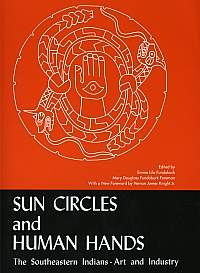
|
Sun
Circles and
Human Hands: The Southeastern Indians – Art and Industry Edited by Emma Lila Fundaburk & Mary Douglass Fundaburk Foreman With a new Foreward by Vernon James Knight, Jr. University of Alabama Press 1957/2001 reprint ISBN# 0-8173-1077-0 oversized paperback
I was twelve years old and completely obsessed with the archaeology of Egypt, Greece and Rome when an uncle gifted me with copies of the original publications of these awesome books. My uncle, an avocational historian, was intent on re-focusing my interest in archaeology and these books were met with open awe on my part. I’d never realized the breadth of prehistoric American civilization! Absolutely jam-packed with pictures, illustrations and riveting historical “first-contact” references and quotes, Sun Circles and Human Hands covers a vast area, extending westward as far as eastern Oklahoma. I do not believe, to this day, that there is any single volume of work so accessible to every audience, so easy to read and look at, so inspiring a tome about American Indians. Even today, years after reading this book, I found myself, childlike, laying on the floor, flipping randomly though the book, totally engrossed in its contents. Nothing is left out--- from pebbles and geodes, to wood artifact, flint artifacts, pottery, baskets, and all sorts of ephemeral items--- all this plus discussions of southeastern sites, travels of early visitors to the area and studies of the iconography of the Southeastern Ceremonial Complex. Some of the artifacts pictured in this book are available nowhere else, and thus, the book transcends time and remains a valuable resource for serious research today. When Henry Shetrone first published The Mound Builders in 1930, people thought that the mounds were built by a race of lost giants. Shetrone’s book was one of the first of its kind available to the public which debunked the myths and introduced us all to these ancient ancestors of modern Native Americans, who, as skilled artisans and engineers built the huge mounds and massive earthworks to live upon and defend themselves. I believe, as a twelve year old, this was the longest book (at 20 chapters and nearly 500 pages) that I had ever read, and I pored over every page! Shetrone, a self educated avocationalist eventually awarded an honorary PhD in 1944, dedicated his book “to the average man and woman who, although fully awake to the human interest in their story, lack time and opportunity for digesting the rather extensive but often unavailable literature on the subject.”This book, lacking an accurate chronological framework, nonetheless represents an amazing lifetime of study and the author’s contribution to the golden age of archaeology in Ohio. By writing for a layman audience Shetrone was strongly criticized in his time. As Bradley T. Lepper writes in his introduction, “There is an unfortunate presumption that ‘real scientists’ do science; that is, they do research and write up the results for their colleagues. They do not deign to write for the uninitiated masses. Shetrone, by doing just that, and doing it quite successfully, drew increased attention to his non-academic background, allowing self-conscious (and self-righteous) “professionals”… to dismiss his real contributions to the field. And Shetrone’s contributions were considerable.” I appreciated Lepper’s new introduction for its biography of the author. I give the University of Alabama Press a standing ovation for reprinting these fantastic classics of American Archaeology and invite you to not only purchase both of these books, but to be sure to peruse the entire Classics in Southeastern Archaeology Series of reprints. Buy a copy for yourself, or treat a youngster to these classics! Order Sun Circles and Human Hands direct from the publisher, for $29.95, by clicking here. Order The Mound Builders direct from the publisher, for $35.00, by clicking here. Peruse the entire Classics
in Southeastern Archaeology Series! All
are
available here.
reviewed
by
Bob
Wishoff
|
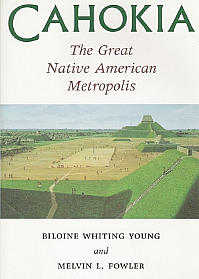
|
Cahokia:
The Great
Native American
Metropolis Biloine Whiting Young and Melvin L. Fowler University of Illinois Press 2000 ISBN# 0-252-06821 paperback/hardback “Monuments anchor the present to a chain of historic events that are responsible for the current structure of reality.”(p.227) Around AD1000 a vast Native American city began to arise in the American Bottom east of the Mississippi River, growing in time to almost 20,000 inhabitants. It encompassed hundreds of monumental structures, the main one over a hundred feet high with a base covering 16 acres, laid out around four massive courtyards. The site had several huge ‘woodhenges’ that incorporated exacting astronomical calculations, composed of over 48 yard-thick posts. Its stratified political and religious hierarchy exerted an influence that was felt throughout the continent, sitting in the middle of a massive trading network that spread across North America. By the time white men finally made their way into the area, naming it Cahokia after a tribe of the Illinois Confederacy living in the area at the time, little remained of this ancient culture but mounds, scattered pottery and occasional speculation by archaeologists. The largest structures were ultimately saved by the very bulk of earthenwork that went into their construction, but many of the smaller other mounds were plowed over, destroyed to make way for railroads and highways, or used to fill low spots in farmer’s fields. The expanding new metropolis of St Louis, first established over outliers of the Cahokia community, threatened to completely engulf and annihilate all signs of the city that had once been. The story of how the greatest pre-Columbian population center north of the Rio Grande came to be understood for what it was and rescued from oblivion is one of the truly great stories of American archaeology. The partnership of Biloine Young and Melvin Fowler, bringing together a skillful authoress and the archaeologist primarily responsible for much of the work at Cahokia, has produced a book worthy of the story. It is rich in detail about its rediscovery, near disappearance under interstate highways and housing developments and how the eventual recognition of Cahokia’s historic value led to its purchase by the state of Illinois for preservation, recognition as a U.S. National Historic Landmark and named as a World Heritage Site by the United Nations in 1982. The book starts with Fowler, working for the Illinois State Museum at the time, being called upon to investigate rumors of a highway being built through the area. From the first paragraph Young masterfully develops the multifaceted personalities involved in Cahokia’s precarious history over the centuries, drawing upon Fowler’s firsthand experience, interviews with many of the individuals involved and a broad spectrum of background material. It is a story of archaeologists at their work, replete with amusing anecdotes, simmering animosities and moments of serendipitous discoveries of dazzling significance. They are shown hard at work to keep ahead of bulldozers waiting to plow under their site, trying to sump out hard dug pits filled with torrential rainfalls and slumping clays, drinking hard at local mob owned bars and struggling for the funding not only for grants but to eke out a living. The camaraderie of amateurs, local laborers, shadowy private collectors, grad students and professors working together is portrayed in a manner that makes the day to day work at the site come alive with real characters. But interwoven throughout is the story of the peoples who built Cahokia. Fowler infuses a strong grasp of the archaeological importance of various features and discoveries, with a keen eye for the implication of features that are uncovered and how they contribute to our overall understanding of this flowering of the Mississippian culture, as well its demise. The architecture, mound building processes, local artifacts, trade networks, agriculture, cosmological views and cultural implications are masterfully described at length, giving an in-depth overview of Cahokian society. By presenting these archaeological bits of the puzzle in the order in which they arose, the reader is able to share in the process of putting together the larger picture as it emerges. The importance of context in interpreting even the smallest find is made clear, making even more acute the heartbreak of a photo of the massive Powell Mound being destroyed by steam shovel in 1930. Its rich cache of grave goods and skeletons was hauled off together with the mound’s soil to fill a nearby bog because $3000 couldn’t be raised to meet the owner’s offer for a more proper excavation. (The only hints of its contents coming when the contractor allowed two professors a few moments up in a the steam shovel’s scoop to investigate a cascade of beads and bones, all hauled off with the rest; no artifacts were ever salvaged from this mound.) More successful excavations in the area are also described in a manner befitting their significance, full of detail and insight into the scientific method at work in deciphering their meaning. Young and Fowler have produced a
wonderful
collaboration here. It is one of the best books out there on the
subject of Cahokia, readily accessible to the lay reader, fascinating
for
the avocationalist and amateur archaeologist, and astute in it’s
depiction
of the practicing professional at work. It is an invaluable
addition
to the library of anyone with an interest broadening their awareness of
the complexities of pre-Columbian Native American culture. It is
available in hardcover for $55.00, but a very serviceable paperback
edition
of over 370 pages, complete with the maps, diagrams and many otherwise
unavailable photographs, is only $24.95. You can order it
directly
from the University of Illinois Press website by clicking here
, where you will also find a link to the table of contents and
illustrations. reviewed
by
Charles
Swenson
|
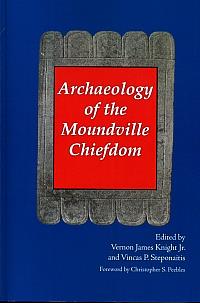 |
Archaeology of the Moundville Chiefdom
Originally published by the Smithsonian Institution Press, this new edition of Archaeology of the Moundville Chiefdom, brings together the latest research in this important Native American town. Nine specialists in the field come together in this volume with papers which discuss population trends, explore domestic life and subsistence practices on the river, basically weaving together a “new history” of Moundville town life. Archaeology of the Moundville Chiefdom is available, at the publisher’s website in cloth hardback, for $45.00. This review was of the paperback edition, one that may already be out of print. Order the book direct by clicking here. reviewed
by
Bob
Wishoff
|
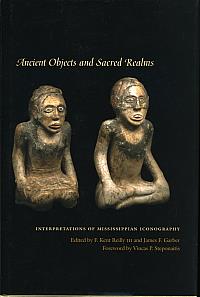 |
Ancient Objects
and Sacred Realms Part of the Linda Schele Series in Maya and Pre-Columbian Studies, this book brings together ten essays by respected scholars in the fields of anthropology, archaeology and art historians. These essays point out the weaknesses in the current label for the body of study, namely the Southeastern Ceremonial Complex (SECC). The editors point out that while the people of the region all shared religious concepts, they comprised separate entities which included those outside of the southeastern US, and should rightly be referred to as incorporating an “interaction sphere” similar to one posited for the Olmec Heartland in Mexico. Reilly and Garber prefer the Mississippian Iconographic Interaction Sphere (MIIS) to the old SECC label. reviewed
by
Bob
Wishoff
|
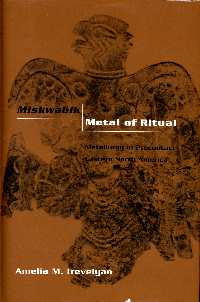 |
Miskwabik “Miskwabik means
‘copper’ in
the Native American language of the Ojibwa tribe.” That copper was
central to
five major ritual manifestations in eastern North America there has
never been
an argument. The Old Copper Culture, the Adena, Hopewell, Copena and
Southeastern Ceremonial Complex peoples all used copper but
for many years scholars were unwilling to believe that Native Americans
had the
wit to exploit deposits of native copper. It has only been in the last
three
decades that techniques have been developed to source copper and in
many cases,
the locations of mines were closely kept secrets. As well as
exploring what the author calls "a consistent history" of copper use by
Native Americans, there are also chapters exploring "Meaning and
Significance in Design and Material", "Copper: Its Ceremonial Role",
and also includes a comprehensive Appendix that explains, among other
things, the methodology of the analysis of motifs used in copper
artifacts-- an invaluable reference in itself! The Appendix also
includes maps, further notes and data tables refered to in text. One interesting
observation made by the author is that artifacts made of copper from
the Amercan Northwest are similar to some found in eastern North
America! Trevelyan posits that the material had similar meanings to
Native American across the continent, positing the copper's red color
makes it easy to associate with blood, or other things red, such as
salmon flesh. Miskwabik is an incredibly
interesting book on a topic rarely discussed in such depth! You'll
enjoy every word of it. Miskwabik
is available directly from the publisher, for $50.00
(hardback) and can be ordered by clicking here. reviewed
by
Bob
Wishoff
|
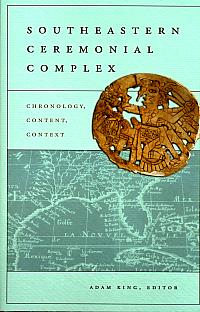 |
Southeastern
Ceremonial Complex: Chronology, Content, Context Edited by Adam King University of Alabama Press 2007 1st ed. paperback ISBN# 978-0-8173-5409-1 Thanks
to
the University of Alabama
Press, the long awaited sequel to Southeastern
Ceremonial Complex: Artifacts and Analysis is at last in print. Since the first edition, there have been many
advances in the understanding of the concepts, themes, and artistic
styles
traditionally associated with the Southeastern Ceremonial Complex. At
the
forefront of this new knowledge is the increased complexity of the
Complex
itself. Southeastern Ceremonial Complex:
Chronology, Content, Context is a
masterful venue that will enlighten a mass audience to this otherwise
perplexing
culture. The
Editor, Adam King, and many of the
leading scholars of this region contribute selections that run the
gambit from
premier mound sites such as Cahokia, Moundville and Etowah to the
iconographical interpretations of objects. Contributing
authors include James A. Brown, who discusses
the
chronological implications of the bellows-shaped apron, and Vernon
James Knight
who writes of cult designs on pot sherds from Moundville. Adam King
penned two chapters;
Chapter One brings the reader up to date on Southeastern Ceremonial
Complex research
since the initial volume’s publication. In his second chapter King
discusses Mound
C and its history. Order this book directly from the publisher for $42.50, by clicking here. reviewed
by
Mark
Barnett
|
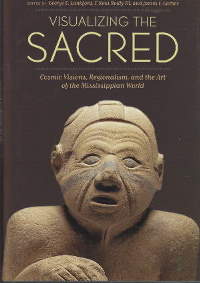 |
Visualizing
the Sacred The Southeastern Ceremonial Complex, located in the Mississippi River valley as well as other areas of the eastern Woodlands of the United States is the continuing source of innovative research regarding some of North America’s most interesting and complex cultures. The scholars studying these cultures are spread across the span of America… it is difficult to coordinate all of the diverse ideas, and a synthesis of all of this knowledge is only now being understood and articulated. Much of the credit must be given to F. Kent Reilly and his innovative workshops, held annually at Center for the Arts and Symbolism of ancient America, located in the Anthropology department at Texas State University-San Marcos, Texas. I was privileged to attend the Iconography Workshop several years ago, and was able to see firsthand how the research presented here came together. Like this volume’s predecessor, Ancient Object and Sacred Realms (also reviewed by me), also summarized the work done at these conferences. The conferences allow the authors and their colleagues to collaborate in a level of intensity not possible by other means. The conferences are creative and hectic, with workshops lasting well into several evenings. This kind of immersion is bound to bring to light a myriad of incredible ideas, and does just that, year after satisfying year. There is so much content within this book! Bringing archaeological, ethnographic, ethnohistoric, and iconographic perspectives to the analysis of Mississippian art, contributors from several disciplines discuss variations in symbols and motifs among major sites and regions across a wide span of time and also consider what visual symbols reveal about elite status in diverse political environments. These findings represent the first formal identification of style regions within the Mississippian Iconographic Interaction Sphere and call for a new understanding of the MIIS as a network of localized, yet interrelated religious systems that experienced both continuity and change over time. Simply put, both volumes in this series are already classics in the field of iconographic research. If they are missing from your library, you need to order them before they are sold out! If you order the book directly from the publisher’s website, you get this $60 hardback for a third off, or only $40.20… click here to see the book’s Table of Contents, to read an excerpt, and to order! |
| Home | Gallery | Latest Finds | Back to Main Book Review Index |